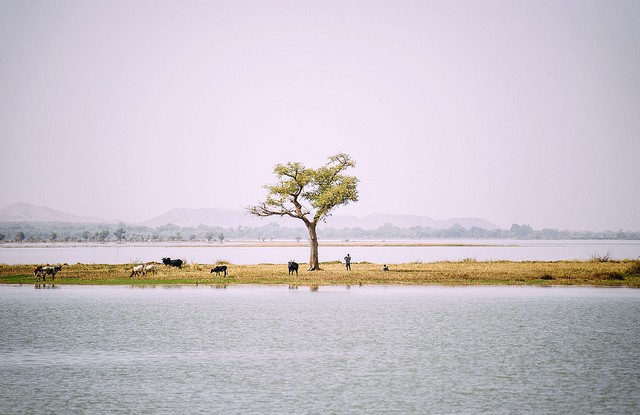BOGOR, Indonesia (29 October 2013) — Every year, the long queues of vehicles, donkeys and pedestrians that form at impassable river crossings around Lake Bam after rainstorms become less frequent.
Is it because of better road infrastructure? Is it because of receding water levels in the lake? What role is climate change having? It is difficult to determine, in part because there has been little research looking at all those factors, according to a scientist with the Center for International Forestry Research (CIFOR).
So many natural and human factors influence the environment in the Lake Bam area in northern Burkina Faso that fragmented, short-term approaches to research there and in other forested landscapes have largely failed to address the big picture, said Michael Balinga, regional scientist for CIFOR in West Africa based in Ouagadougou, the capital.
A new approach to collaborative research over the next few decades at key sites such as Lake Bam could offer insights into the evolution of forest landscapes, Balinga said.
This is why Lake Bam is included in the West Africa Sentinel Landscape (WASL) program, one of eight such programs identified worldwide by CIFOR and its partners. Sentinel landscapes act as field laboratories to observe changes and the factors driving them — be they human or environmentally induced.
NEW APPROACH TO RESEARCH
“In the past, the way research has been organized was driven by funding and individual interests of researchers, so it took a snapshot at a given time,” said Balinga, WASL coordinator.
Scientists will gather data and measure change in each of the eight sentinel landscapes to understand better how these areas interact with global processes. The overall aim of this approach is to examine the role of forests in connection with other land use and livelihood outcomes to help improve natural-resource management and contribute to global decision-making.
A new approach to forest research will expand the typical three- to five-year study period for focused scientific projects into decades of cross-disciplinary data collection and analysis to deepen scientific knowledge of forested environments, Balinga said.
“The sentinel landscape approach is intended to replace a snapshot view with a long-take filmic approach — decades of sustained monitoring are needed if we’re to understand long-term processes such as climate change,” he added.
Balinga said that collaboration among various scientists in the sentinel landscapes approach will also broaden the scope of their research. “It’s as if we were zooming out of the forests and starting to see how different factors are related through a high-angle shot,” Balinga said.
In the past two years, scientists have selected multiple landscapes for sentinel scrutiny, crosscutting through a range of different forest systems around the world. Six are geographic (two apiece in Latin America, Southeast Asia and Africa) and two are thematic (one looking at the palm oil industry and the other at production rainforests).
The West African Sentinel Landscape stretches from eastern Mali to northern Togo. It was chosen because its features are representative of the wider Sahel region.
“It’s like a watchtower from which we will collect long-term data on the evolution of various biophysical, human and environmental features,” Balinga said.
SENTINEL SITES
In Burkina Faso, Lake Bam is the site where scientists can study the impact of some of the older processes affecting changes in the landscape. Due to its long history of cotton farming linked to migrations and deforestation, the area has become dryer and its soils poorer.
Farther south in Burkina Faso, another sentinel site, Kassou, is ideal to observe a more recent process. “Cotton farming is moving southwards, where there is more forest and fertile land,” Balinga said.
“Will the same decisions and factors have the same effects there as in Lake Bam? Maybe, maybe not — the area is more humid, the people’s culture and ethnicity are different. That’s what we want to find out.”
Since an initial meeting in Ouagadougou last January, researchers from local and international organizations across the West African Sentinel Landscape have been working together to determine how to collect “baseline” data — the starting point from which they will monitor factors including social and economic situations, land use and forest degradation.
“It is an opportunity for different researchers and institutions to share resources, data and findings such that we have a broad research program that covers all the different inter-related elements that no one institution or researcher could have covered on his own,” Balinga said.
Collaboration and standardized methodologies will avoid duplicate work between scientists, and persuade donors to commit funding for longer-term research, he said.
For further information on the topics discussed in this article, please contact Michael Balinga at m.balinga@cgiar.org
Some of these topics will be covered at the Global Landscapes Forum at the Warsaw Climate Change Conference in November 2013.
This work forms part of the CGIAR Research Program on Forests, Trees and Agroforestry.
We want you to share Forests News content, which is licensed under Creative Commons Attribution-NonCommercial-ShareAlike 4.0 International (CC BY-NC-SA 4.0). This means you are free to redistribute our material for non-commercial purposes. All we ask is that you give Forests News appropriate credit and link to the original Forests News content, indicate if changes were made, and distribute your contributions under the same Creative Commons license. You must notify Forests News if you repost, reprint or reuse our materials by contacting forestsnews@cifor-icraf.org.
